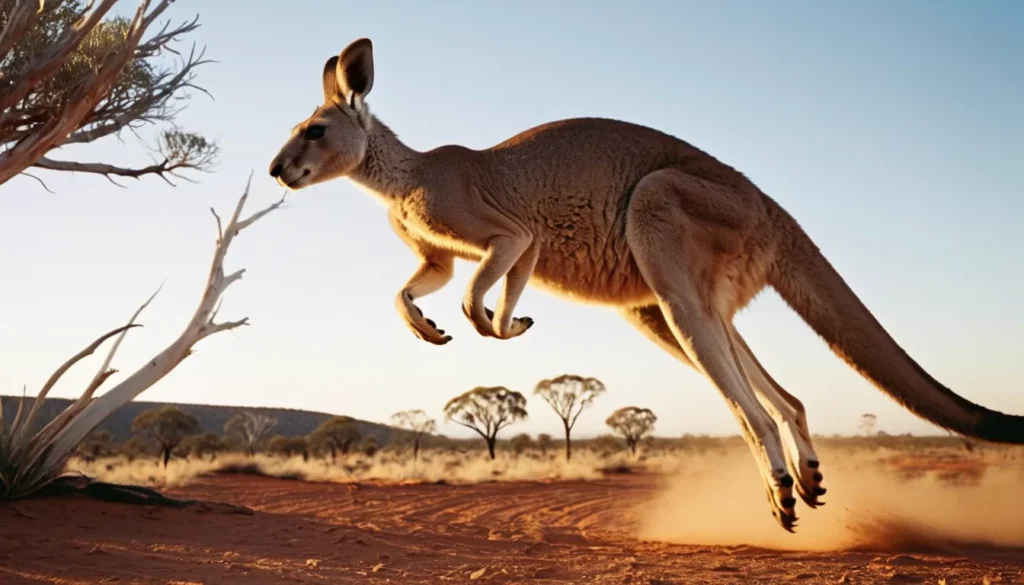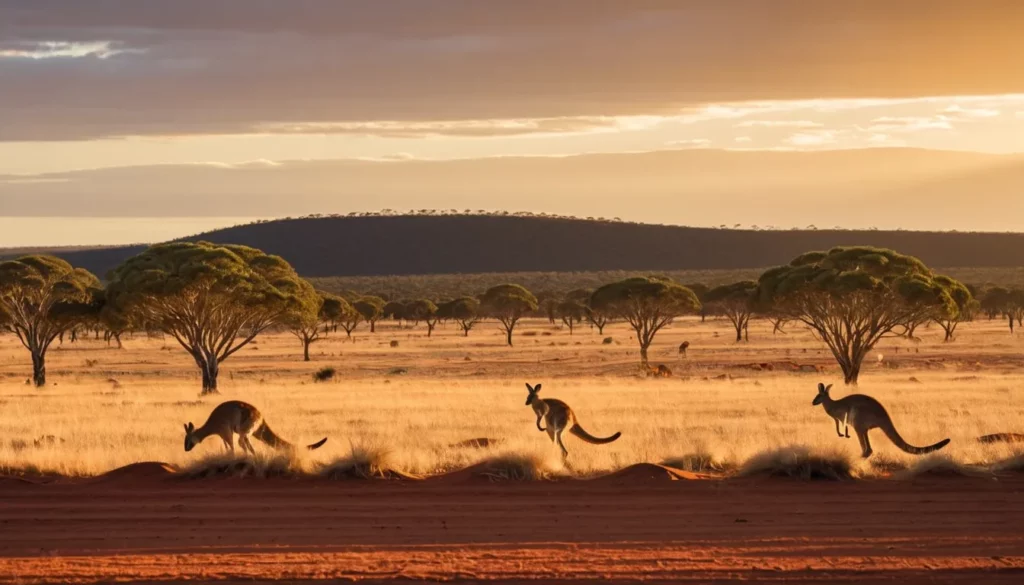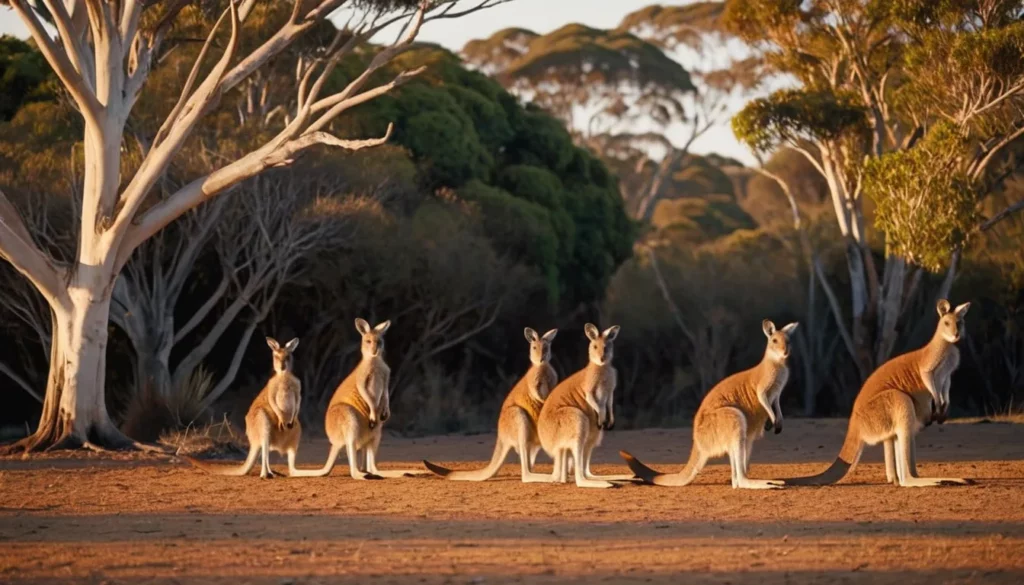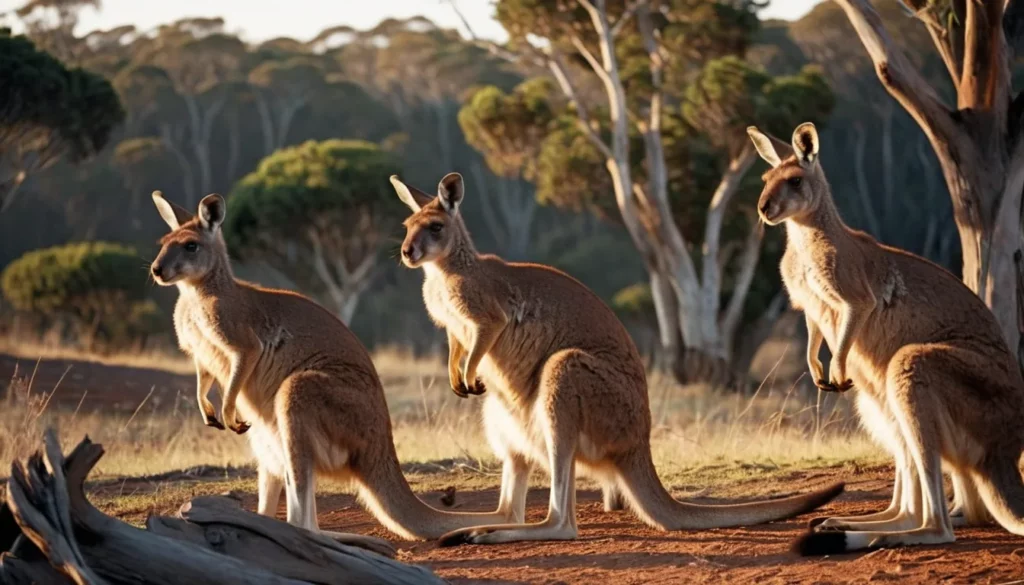Unveiling 12 Interesting Facts About Kangaroos

Kangaroos hold a special place in Australia’s landscape and culture. These iconic marsupials have captured the fascination of people worldwide with their athletic hopping, cute joeys, and adaptations to the harsh Australian outback. Kangaroos are also engrained in the traditions of indigenous Australians. This article will highlight 12 interesting facts about the biology, behavior, ecology, and cultural significance of kangaroos. From their powerful hindlegs to their unique reproductive system, we’ll explore what makes these quintessential Australian mammals so remarkable.
1. Kangaroos Are Endemic to Australia

Australia is the only place where you can find four kinds of big kangaroos: red, eastern grey, western grey, and antilopine. Kangaroos are endemic to the country and cannot be found naturally anywhere else in the world.
There are also over 50 smaller kangaroo species like wallabies and tree kangaroos native to Australia and New Guinea. Kangaroos have remained isolated in Australia for thousands of years, adapting to the landscape. As a result, they are strong symbols of Australia’s unique wildlife.
2. They Are Marsupials That Carry Joeys in a Pouch
Kangaroos belong to the marsupial family of mammals. One key difference between marsupials and other mammals is that female marsupials have a pouch. This pouch, called a marsupium, is where their young grow and develop.
Marsupium comes from the Latin word for “pouch”. After giving birth, newborn kangaroos called joeys are only about 2 cm long. They instinctively crawl into the mother’s forward-opening pouch and latch onto a teat.
Joeys remain continuously nourished and protected in the pouch for around 9 months as they grow. Eventually, they start venturing out of the pouch but continue to nurse until 18 months old.
3. Powerful Hind Legs Allow Them to Hop at High Speeds
Kangaroos have big and strong hind legs and feet that stand out the most. These provide the power and leverage for them to hop around their habitat at high speeds.
Using their tendon-like tails and strong hind legs for propulsion, kangaroos can hop at over 70km/h (40mph). This hopping gait is extremely energy efficient. Their hind feet are also large with four toes and claws for grip.
The red kangaroo can leap over 9 meters (30 feet) in a single powerful bound and jump up to 3 meters (10 feet) vertically. Kangaroos can hop far to escape predators and travel in Australia’s vast outback.
4. They Live in Mobs with Complex Social Structures

Kangaroos are highly social animals that live in groups called “mobs” that typically have 10 or more individuals. A mob is usually led by an alpha male kangaroo.
In favorable habitats with abundant resources, mobs may merge to form larger aggregations of over 100 kangaroos. They have complex social structures and communication patterns.
Kangaroos communicate with their groups using visual signals like pulling their ears, thumping their tail and foot, hissing, and changing their posture. Males will also box by kicking to establish dominance. Their social behavior helps maintain cohesion in their challenging environment.
5. They Have a Unique Reproductive System
Female kangaroos have an intriguing reproductive system that includes:
- Embryonic diapause is when fertilized eggs delay development until conditions are favorable.
- Female kangaroos can have three joeys at different stages of development due to their reproductive system.
- Continuous cycles – They can be continuously pregnant, nursing previous young while another embryo is on standby.
Kangaroos can adjust their reproduction to Australia’s changing weather using a special system.
6. Kangaroos Use Their Tail for Balance and Support
The kangaroo’s large, thick, muscular tail is a key part of their movement. They use their tail:
- For balance – Kangaroos lean on their tails like a third leg when standing upright. Their heavy tail provides crucial counterbalance when hopping at high speeds.
- For support – Their tail helps prop them up when resting on their hind legs and provides a “tripod” with their two hind feet.
- As a rudder – When swimming, kangaroos use their tail to steer and propel them through the water.
Kangaroos need their tail for balance and support to hop and stand upright. Work those tails!
7. They Are Most Active at Dawn and Dusk

Kangaroos are crepuscular animals, meaning they are most active around dawn and dusk. This is when they venture out of their resting areas to graze and socialize.
During the cooler times of morning and evening, kangaroos hop around shrublands and grasslands looking for plants to eat. They are well-adapted to seeing in low light conditions at these times.
During the heat of the midday, kangaroos rest in the shade to stay cool and conserve energy. They dig “nose pits” in the soil under trees and bushes to take advantage of the cooler earth.
8. Kangaroos Have Excellent Sense of Smell and Hearing
Two of the kangaroo’s sharpest senses are their abilities to:
- Smell – Kangaroos rely heavily on scent signals to detect the presence of predators, find food, interact with their mobs, and attract mates. They have highly sensitive noses and prominent nostrils.
- Hear – With large, independently swivelling ears, kangaroos have excellent hearing adapted for the open Australian landscape. Their ears can pinpoint sounds from great distances and heights.
Their ears also play a role in thermoregulation, social communication, and courtship displays. Kangaroos can angle their ears to pick up faint sounds from any direction.
9. They Can Swim to Escape Predators or Disperse
While legendary for hopping long distances on land, kangaroos are also capable swimmers when needed. They will take readily to lakes, rivers, and water holes.
Reasons kangaroos enter water include:
- Escaping predators – Using water bodies to escape from pursuing predators like dingos.
- Dispersal – Males sometimes swim between areas to increase breeding opportunities.
- Drought conditions – Seeking out water sources during severe drought.
In water, kangaroos paddle with their forelimbs and use their tail for steering–almost like a rudder. Even joeys in the pouch can hold on tight while their mothers swim.
10. Lifespan Ranges From 6 to 15 Years in the Wild

In their natural habitat, kangaroos live around 6-8 years on average but can survive up to 15 years. Bigger kangaroos, such as reds, greys, and antilopines, live longer than smaller ones.
Their lifespan depends on factors like availability of resources, droughts, predation rates, and hunting pressure. Those living in captivity under protected conditions may live even longer.
11. They Cannot Jump Backwards
Due to the specialized anatomy of their hind legs and tail that are designed for forward hopping, kangaroos cannot jump in a reverse direction. Their tendons store elastic energy for powerful forward propulsion.
Kangaroos moving backward will awkwardly crawl on their forearms. Their ethos is to always move forward efficiently, so they don’t jump backwards to escape predators. Anatomically, they are built for forward-directed hopping.
12. Kangaroos Play Important Roles in Aboriginal Culture
Kangaroos are important in Australian Aboriginal culture. Songs, paintings, legends, and stories feature them. Kangaroos symbolize speed, family bonds, gracefulness, and Finding nourishment during hardship.
Aboriginal tribes hunted kangaroos for food and made things like cloaks, bags, and water carriers from their hide. Kangaroos remain culturally significant to Aboriginal Australians today.

Key Takeaways on Kangaroos
FAQ
What’s the cultural importance of kangaroos in Australia?
Kangaroos symbolize Australia’s unique culture and heritage, particularly for indigenous Australians.
Where can you naturally find kangaroos?
Kangaroos are endemic to Australia and don’t naturally exist elsewhere.
How many types of large kangaroos are in Australia?
There are four major types: red, eastern grey, western grey, and antilopine.
Can kangaroos hop fast?
Yes, they can reach speeds over 40 mph and jump up to 9 meters in one leap.
How do kangaroos typically live in groups?
Kangaroos live in “mobs” of 10 or more with intricate group dynamics.
Conclusion
Kangaroos are truly distinctive creatures that are excellently adapted to their dry, open habitat. They are also embedded in the cultural fabric of Australia, especially for Aboriginal and Torres Strait Islander peoples. While several species still face threats, robust populations show that coexistence with humans is possible with careful management.
As symbols of Australia, the conservation of kangaroos and their habitat should remain a priority. Their athleticism, family bonds, and resilience also make them endearing animals worldwide. These 12 facts illustrate why kangaroos continue to hop into the hearts and minds of people across the globe.





